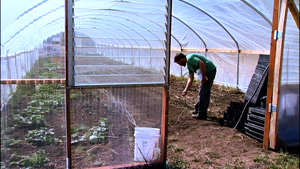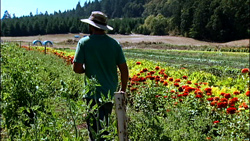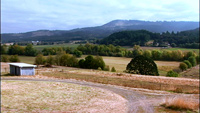*Five million family farms have been lost since the 1930’s. As the population of family farmers continues to age, there is also a critical shortage of young farmers to take their place. Michael Paine is a rare breed; he doesn’t come from a farming family, and he’s relatively young. His story is a good example of the unique challenges facing those who wish to take up farming.
I read this in my local paper awhile back: “Oregon is one of the only bright spots in the country where we’ve got young farmers coming into the business…”. Hmmm, I knew most farmlands were industrialized, but I thought, with the growing interest in locally produced food, I would think the family farm would also be growing.
I contacted Dianne Stefani-Ruff from Portland Farmers Market, who made the quote, to see who might just be one of those new young farmers. She gave me the names of 4 or 5, and I never got past the first one I called, Mike Paine of Gaining Ground Farm. I knew right away he was someone who was very passionate about farming. He wasn’t born to farming, like many are, but raised in the suburbs. He had a garden as a young adult, but that was about it. His drive to become a farmer really sprouted from his experience in Africa in the Peace Corps in Costa Rica, and, finally from working on his Masters degree at UC-Davis in Agriculture.
Sustainable agriculture is a growing field. Many farming methods that may have been lost to time are now returning. One that Michael puts to practice is using chickens to ready his fields. He puts them in portable coops that are moved along the field after the group of chickens scratch, peck the ground, and leave behind a rich manure. Recently he created a pond to catch the natural drainage of water from the hills. This water will be used to irrigate his crops.
Using organic methods, some of the vegetables he grew this year were tomatoes, melons, squash, mixed green lettuces, eggplant, and beans. They were all beautiful. I really enjoyed his sharing all the different varieties he grew, many I never heard of. I think the people who come across his vegetables at the farmer’s market and who are shareholders in his CSA are very lucky indeed. If you’re not familiar with what a CSA is, check out the story I did on Laura Masterson’s farm, in Food Network: Community Supported Agriculture
Recipe from the show: Fall Carrot Soup
There is a lot of hard work involved in farming. I knew that. But what really surprised me is how hard it apparently is to get your first farm. It even surprised Mike. Does it surprise you? Here’s some alarming information about the state of family farms in America today, and the respective ages of these existing farmers.
From Farm Aid:
In the 1930s, there were close to seven million farms in the United States. Today, just over two million farms remain, and only about 25% of these are family farms. In 2004, the USDA Economic Research Service (ERS) predicts that 98 percent of total farm operator income will come from off farm sources and at last count only 7 percent of all farm families reported 100 percent “on-farm” income.
More than half of today’s farmers are between the ages of 45 and 64 and a quarter of the farmers in this age group plan to retire by 2005.
Only six percent of our farmers are younger than 35.
The complete Farm Aid article is titled, “Why Family Farmers Need Help”
*Update: According to the latest 2007 USDA National Agriculture Statistics Service, roughly 4 million family farms have been lost since the 1930’s, though it should be noted that small farms (50 acres in size, or less) have increased about 13% compared to the earlier USDA 2002 census data).
Most of the videos featured on Cooking Up a Story were produced, filmed, and edited by Rebecca Gerendasy. Fred Gerendasy contributed as a writer to many of the posts and occasionally as the interviewer. Visit Rebecca Gerendasy Clay – Art and Fred Gerendasy Photography to see their current work.



